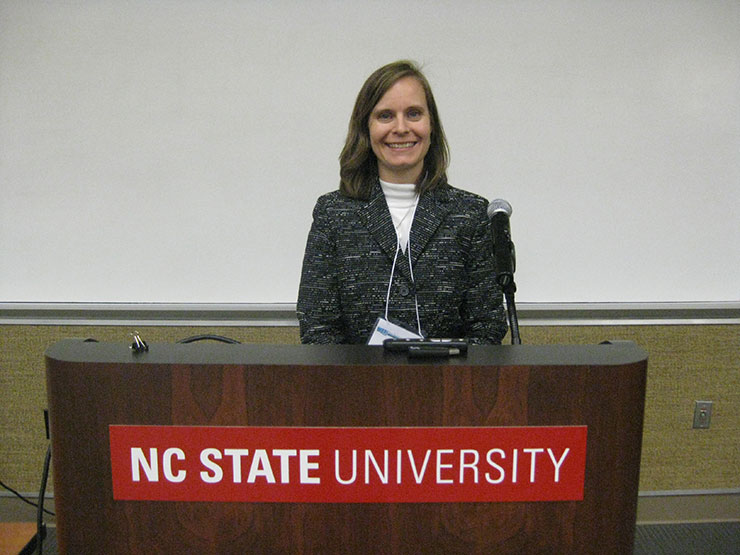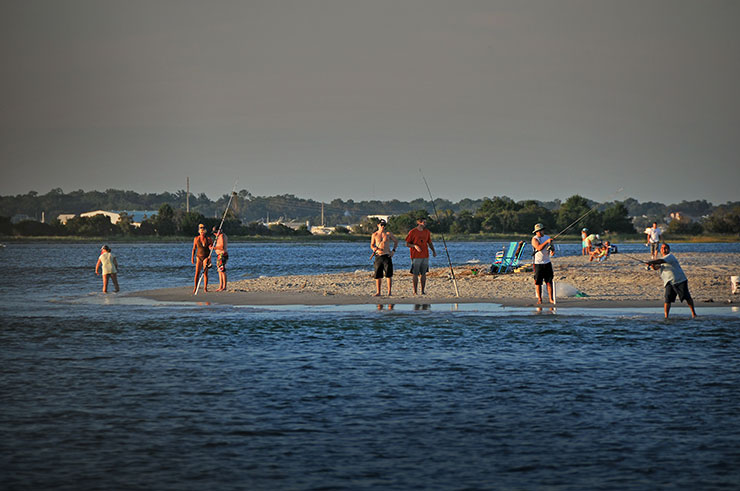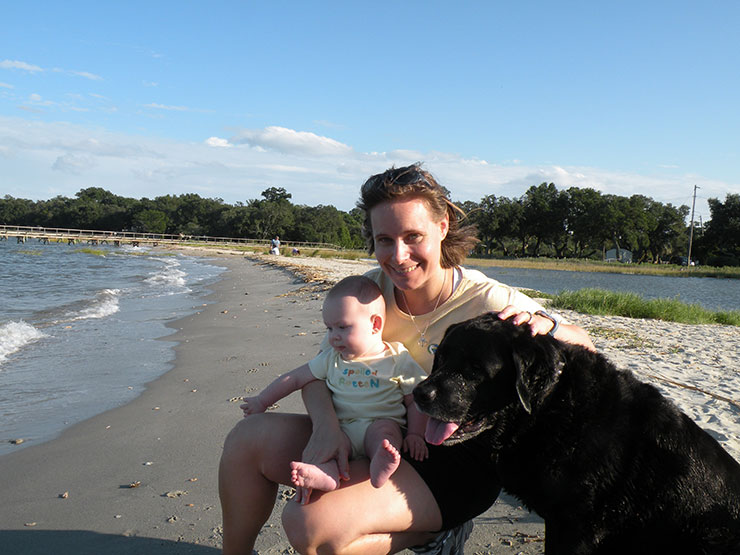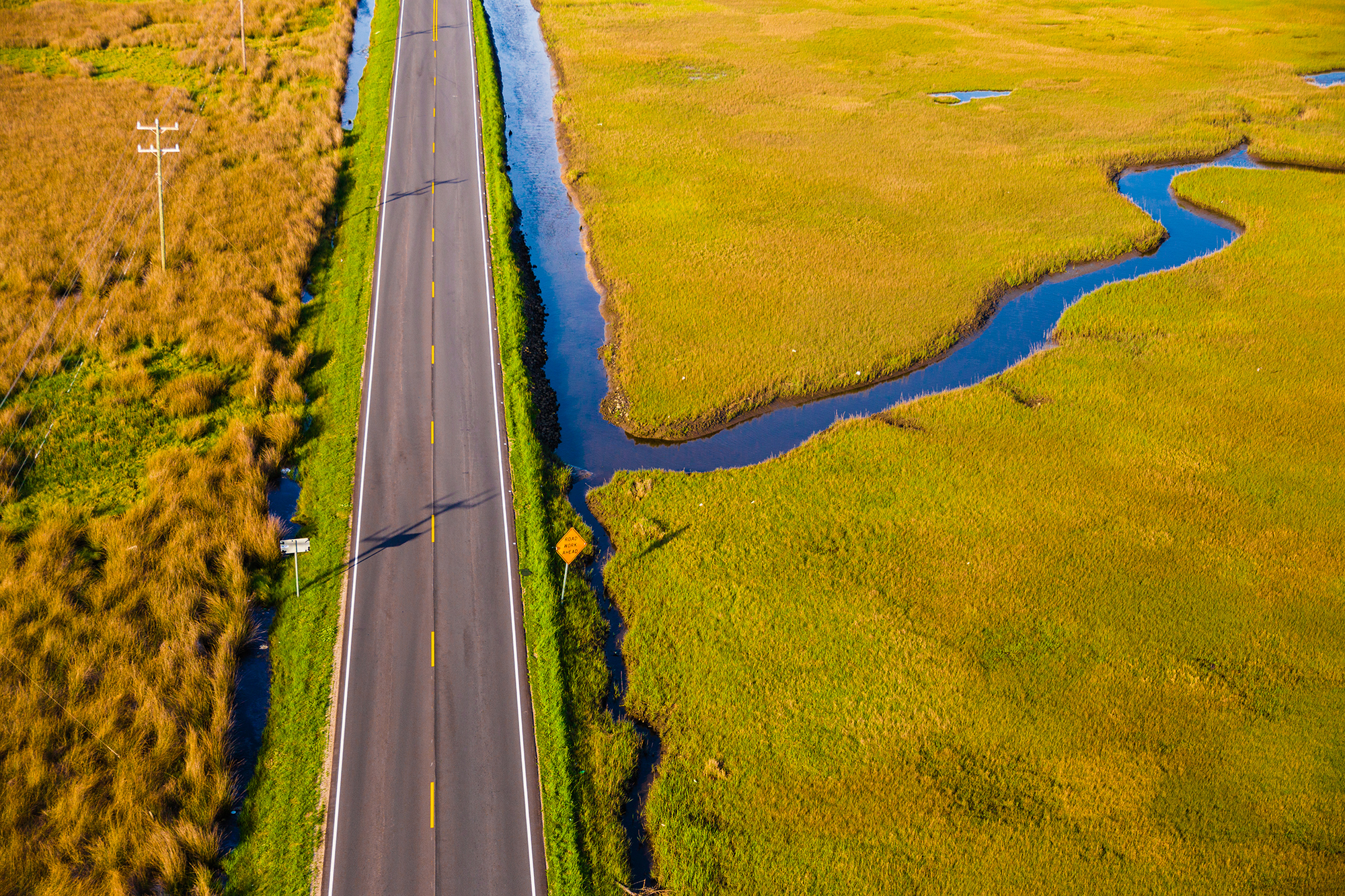Then and Now: Susan White Returns to North Carolina

Susan White chuckles as she remembers undergraduate adventures piloting the research skiff in estuarine waters near the Duke University Marine Laboratory.
But that semester on Pivers Island helped chart her career course in coastal science. With her classes right next door to the National Oceanic and Atmospheric Administration’s Beaufort Laboratory, she joined a research project with Bill Kirby-Smith of Duke and Carolyn Currin of NOAA. Both are still professional colleagues.
“We looked at salt marsh restoration and survivability,” explains White, now executive director of North Carolina Sea Grant.
Those early skills in analyzing sediment cores and water samples gave her ways to measure changes in the coastal environment. Her hours in the skiff, in the marsh and in the lab began a quest that continues today as she looks at problems facing coastal resource managers, elected and appointed officials, business owners and residents.
In her whirlwind first few months at Sea Grant, White has had multiple visits to the coast, but alas, no time to bundle up in waders and layers to venture out for field work. Instead, she has more informal fact-finding missions: learning about critical and emerging topics and needs along the coast and through the watersheds.
“I have met with Sea Grant staff, researchers and advisory board members, as well as university and community partners, agency colleagues and so many others,” she explains. “There are many perspectives,” she notes, “but most have similar ultimate goals that focus on the sustainability of coastal ecosystems and communities.”
BACK HOME
White is glad to be back home in North Carolina, she told readers in her letter in the last issue of Coastwatch.
Growing up in a rural section of Orange County, she spent endless hours outdoors. She loved climbing trees and exploring with her siblings. Girl Scouts offered hikes and camping. It didn’t hurt that her parents had professional and personal interests in plants.
But White clearly identifies the point at which she decided she would be an environmental scientist: Third grade.
Teacher Liz Waters was a mentor then and is still a family friend. “She was into science — so excited about it,” recalls White, who also leads the Water Resources Research Institute of the University of North Carolina, another statewide, interinstitutional program headquartered at North Carolina State University.
White continued to nurture her science side through her teens, including participating in environmental clubs at Orange County High School. While family trips to Emerald Isle included traditional visits to the North Carolina Aquarium and general beachcombing, she also had an “in” to observe researchers at work at the Duke Laboratory.

“My father was on faculty,” she notes with a smile. “He especially enjoyed field classes at the coast.” Now retired, Richard White is a botanist who served as Duke University dean of the faculty of Arts and Sciences and the Trinity College, and later director of Duke Gardens. Her mother, NC State graduate Norma White, thrived in her landscape architecture career.
Susan White’s undergraduate program at Duke provided both science and policy perspectives. She initially steered a course toward ecology, entering a doctoral program at the University of Georgia. Her adviser was Merryl Alber, who brought White into projects with the Georgia Coastal Research Council, as well as Georgia’s Long-term Ecological Research Site, funded by the National Science Foundation and located on Sapelo Island.
White’s doctoral research considered connections between freshwater and coastal ecosystems. “We were entering into a long-term drought. I was looking at how changes in water availability can change habitat,” she notes. At UGA, she kept track of North Carolina issues through the Southeastern Estuarine Research Society, which provided “a nice regional exchange of ideas and opportunities.”
CAREER PATH
Upon earning her doctorate, she had options for post-doctoral research or a position with NOAA, and she chose to join the National Estuarine Research Reserve System team at the NOAA headquarters. “I wanted a greater awareness of federal policy,” she says.
“The NERRS network is phenomenal,” she adds, noting that she filled a slot left open by Maurice Crawford, now of Elizabeth City State University. She also met Russell Callender, previously assistant director for Virginia Sea Grant, later lead for the National Centers for Coastal Ocean Science or NCCOS.
“I remember meeting Susan when she was science director for NERRS. She was great to work with,” recalls Callender, now NOAA acting deputy assistant administrator with the National Ocean Service.
White’s NERRS role gave her managerial experiences, including helping the state-based programs function as a national network. But a desire to get closer to the field took her to Charleston, S.C., as deputy director of NOAA’s Hollings Marine Laboratory.

She moved into the lab leadership with the retirement of Fred Holland. He recalls seeing important qualities in her personality. “One of the roles she fit in the Hollings Lab was helping us in the strategic planning — to come up with major thematic areas, and to have each of the partners identify their role and integrate their participation,” he says.
“Susan is excellent at strategic planning and working in complex situations, especially in meetings where there are multiple competing objectives. She can help people to play together and not destroy each others’ toys — and ultimately build a sand castle,” Holland adds.
The Hollings Lab is a partnership with South Carolina agencies and universities, as well as the National Institute of Standards and Technology. “She was an immense help in the Oceans and Human Health program,” Holland notes.
During her doctoral studies and early career, White saw leaps in genetics and technology that would change coastal science, ultimately defining projects at Hollings as well as in her new duties at Sea Grant. “How do we use technology smarter and better?” she notes as a critical, but ongoing question.
Such questions and lessons also were on the agenda as she participated in the December 2011 Tidal Creeks Summit, organized by North Carolina and South Carolina Sea Grant specialists. “The big picture is interdisciplinary,” she says of that meeting, citing creeks as sentinels of so many changes in the coastal environment.
The interdisciplinary focus also is the root of the NOAA in the Carolinas group that brings together Carolinas-based staff from the NOAA line offices, such as the National Weather Service and National Marine Fisheries Service, as well as NOAA-funded programs, such as Sea Grant and NERRS. White joined while at the Hollings Lab and continues on the steering committee.
Her role means she already has good partnerships with colleagues such as Darin Figurskey, who heads the weather service office on NC State’s Centennial Campus in Raleigh, and Rick DeVoe, director of South Carolina Sea Grant.
White also has worked with Braxton Davis, who is now director of the N.C. Division of Coastal Management. He is pleased she made the move. “She is a high-energy and positive person who brings solid experience in coastal science and management issues. We at NCDCM look forward to working with her and all of the excellent staff at North Carolina Sea Grant in the coming years,” he says.
LOOKING AHEAD
As White thinks about what the North Carolina coast will be like in the future, she has a pair of reasons to ensure that it will remain a bastion of natural resources. Young sons Spencer and Mason keep White and her husband, Brian Smith, grounded in the real world.
In fact, at the N.C. Marine Recreational Fisheries Forum that Sea Grant hosted earlier this year, she posed a question to the experts: As her sons grow up and head to the coast to fish, what will they find in terms of species and access?
Her own realities of juggling family and career fuel her management style that draws upon the diverse talents of the Sea Grant staff — and also looks at the opportunities for synergies with WRRI in terms of research, outreach and administration.
“Susan’s background in freshwater, estuarine and marine topics offers a great starting point to see how the Sea Grant and WRRI programs can build upon each other’s strengths,” notes Terri Lomax, NC State vice chancellor for research, innovation and economic development.

Courtney Thornton, associate vice president for research and graduate studies for the University of North Carolina system, also cites White’s skills in collaboration. “I think it is extremely valuable that Susan can apply her experience managing multi-institutional initiatives to managing Sea Grant.”
Chris Brown, UNC system vice president, agrees. He got to know White during a weeklong site review of marine science research programs across the system. “She is forthright and knowledgeable in discussing the role of North Carolina Sea Grant research and outreach,” he notes.
Keeping a focus on those roles — and impacts — is especially important when state and federal budget constraints arise. Working through the challenges to find ways to improve an organization is something that White can do, and will do well, Callender is certain. He was her NOAA supervisor when she was Hollings Lab director.
“She is really smart. She thinks very strategically. She moves forward very purposefully — and that moves a program forward,” Callender says.
He also cites her ability to make and develop relationships at varied levels, from individual researchers to top levels at NOAA. “She works with people, yet she is firm in driving them into new directions.”
Her move was a great loss for NCCOS, he adds. “But it is North Carolina’s gain.”
FOCUSED RESEARCH
After a tour of North Carolina Sea Grant’s coastal offices, and meetings with the staff at the headquarters in Raleigh, Susan White had fresh perspective as she reviewed the final version of the program’s strategic plan for 2014-17.
The state plan, available on the Sea Grant website at www.ncseagrant.org/s/strat2014-17, is built around focus areas:
• Healthy Coastal Ecosystems
• Sustainable Coastal Development
• Safe and Sustainable Seafood Supply
• Hazard Resilience in Coastal Communities
• Environmental Literacy and Career Initiation
Those focus areas, which correlate to ones set by the National Sea Grant College Program, are key points for the new core research funding cycle for 2014-16. Sea Grant received dozens of preproposals by the April 5 deadline, each outlining potential research and citing the relevancy of the topic here in North Carolina.
In-state reviews are now in progress to identify which research topics fit the needs of resource managers, communities and businesses. In past cycles, about half the preproposals submitted are suggested to move to the full proposal round, which will have intense scientific scrutiny from out-of-state reviewers.
“This is a very good process to ensure the relevancy as well as scientific merit,” White notes. “North Carolina has a great mix of coastal researchers, from young faculty to international experts.” The final selection will be completed in the fall, for the new projects to begin Feb. 1, 2014.
On June 19, 2013, White gave a talk on water at RTP 180°. View her presentation at http://youtu.be/nZG_95JP7YU.
This article was published in the Spring 2013 issue of Coastwatch.
For contact information and reprint requests, visit ncseagrant.ncsu.edu/coastwatch/contact/.
- Categories:


